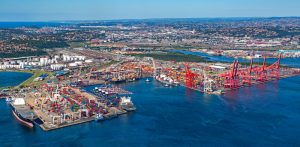“What business strategy is all about is, in a word, competitive advantage. The sole purpose of strategic planning is to enable a company to gain, as efficiently as possible, a sustainable edge over its competitors. Corporate strategy thus implies an attempt to alter a company’s strength relative to that of its competitors in the most efficient way” (Kenichi Ohmae, 1982).
Recessionary markets and increasingly fierce global competition are two of the main challenges facing organisations today in their quest to gain and sustain competitive advantage. However, providing a level of service that stands above the rest can rarely be achieved if a supplier fails to focus on its logistics strategy, argues Tafara Svosve (MSc Supply Chain Management; CMILT). A new management approach that recognises and locates logistics in its rightful place on a strategic platform (rather than merely a support activity) is required if organisations are to achieve and sustain competitive advantage, writes Svosve in this month’s SmartProcurement.
Effective and efficient service is vital
It is no wonder that logistics is emerging as a vital cog in corporate renewal processes. Indeed, logistics can make a huge contribution to the achievement of sustained competitive advantage, in particular if the combined impact of improved customer service and lower cost-to-serve is considered.
Competitive advantage is, generally, gained by offering a customer service of greater value, with lower prices and superior benefits. Logistics, conversely, aims to meet customer demand at the lowest possible cost whilst facilitating the flow of materials, information and funds among supply chain partners. From the perspective of this objective, logistics can put a company ahead of its competitors by ensuring effective and efficient services, such as delivering the right products faster, on time, to the right place and at the right price. With the market becoming increasingly demanding as well as full of uncertainty, there is always a need for firms to be flexible in terms of the above if they are to achieve competitive advantage.
Firms, therefore, need to focus on procurement, transportation, warehousing and inventory, facilities management, information management and customer service in their strategic planning with the objective of improving efficiency in all aspects in order to gain competitive advantage. The proper management of these elements can create rare opportunities for firms as they seek to meet customer demand. Sharing real-time information, more accurate forecasts, cost reduction and agility in the supply chain can be achieved via a logistics-orientated strategy.
Logistics must be applied at strategy level
A notable element within firms today is the classic contrast between the contribution of logistics to competitive advantage and the ability of firms to apply logistics principles in their day-to-day and strategic plans. It is not amusing that some companies relegate logistics issues away from the strategic platform where they objectively belong. This is an error in logistics strategic planning and should not be overlooked. A unified, comprehensive and integrated planning process will achieve competitive advantage through value and customer service, which should result in superior customer satisfaction that will anticipate future demand for logistics services and the management of the entire supply chain’s resources.
The strategic planning of logistics should, nonetheless, happen in the context of overall corporate goals and plans. This requires an understanding of how the different elements and activities of logistics interact in terms of trade-offs and the total cost to the organisation. There is undeniably an increase in complexity in logistics and the supply chain, which necessitates better planning, which can come from trained logistics professionals.
Procurement, transportation, and warehousing and inventory management can no longer be practised as usual if a competitive advantage is to be attained. Organisations thus need to take a proactive approach in their strategic logistics planning process and differentiate their activities from a uniform and predictable model to more responsive models in order to handle increasing complexity.
Manage logistics costs
Transport is a key function of a firm’s logistics activities, therefore, the costs associated with a particular logistics network have to be accurately captured and managed. Transport rates determine what a particular shipment will cost per unit weight for particular distances. Organisations should thus be capable of managing this aspect efficiently if they wish to achieve competitive advantage.
Warehousing costs are also critical for network analysis and can be examined in terms of fixed, storage and handling costs. The capacity of a warehouse facility will determine the flow through the facility. Management should ensure that capacities are at their optimum and avoid unwarranted excessive surplus capacity as this raises fixed costs associated with a facility. Related to warehouse management is the management of inventory, a critical element in logistics strategic planning. Inventory is a key element of every organisation’s balance sheet and affects the financial performance of an organisation. The inventory turnover ratio is an indicator of the efficiency with which an organisation manages its inventory.
Furthermore, service level requirements are a very important consideration when it comes to supply chain and logistics strategies meeting service level criteria as set by management. It is often the case that customers cannot be targeted with the same service level, owing to the heterogeneity of their composition, hence, firms plan specific service levels for different customers.
Logistics can have a significant effect on the overall performance of an organisation
To identify opportunities for long-term competitive advantage, organisations must be aware of and examine emerging management issues in logistics before considering the right logistics strategies to gain competitive advantage in the dynamic world of global competition.
The forces of today’s intensely competitive business environment call for significant changes in how business processes are conducted. As a consequence, many organisations have focused on reducing costs through increased productivity, while also attempting to improve quality and service at the same time.
The result of continually reducing costs and striving to improve service is that a company begins to find itself in the dilemma of being a commodity provider rather than a value-added supplier. To be a value-added supplier means to provide a level of service which stands above the rest – this can rarely be achieved without a focus on logistics strategy.
At Commerce Edge, we understand the importance of logistics at the heart of an organisation’s competitive strategy. We can assist you with your training needs, to enable – and improve – your organisation’s logistics services to your customers.
Tafara Svosve (MSc Supply Chain Management; CMILT) is an experienced and qualified logistics practitioner now focussing on training and facilitation with specialisation in logistics and transport.
























